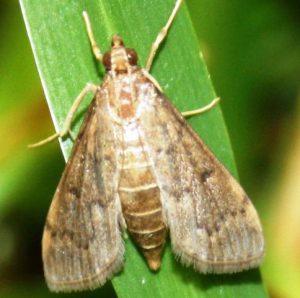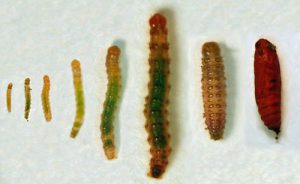Have you been bothered by small brown moths flitting around your landscape? You may find them in your landscape year-round, but may more likely find them from August to October which can lead to negative impacts to the health to your warm season turf. The moth is the adult form of the tropical sod webworm, and their activity is nocturnal. You may,disturb them when walking through the lawn or when jostling your landscape plants. The moths are dull brown and are small. While they can be an annoyance in their numbers, it is not the most effective time to treat them.

The Hungry Turf Eaters
The tropical sod webworm larvae (caterpillars) are destructive to your Zoysia and St. Augustine lawns. The larvae are hatched from an egg masses on the grass blades which like a small blob of tapioca pudding in close-up photos. When the caterpillars have hatched, they are very small and green, and are “window feeders” or eat on the upper surface of grass blades, leaving skeletonized blades as do for the next three instars or developmental stages. During these instars, they are increasing in size, but can easily be missed because of their feeding. You should watch for grass that appears ragged from the early instar feeding. By the time they reach the 5th and 6th instars they are larger with more brown coloration than green. No longer interested in window feeding, they will just eat your turf. They are night feeders so hide in the thatch layer during the day and may even eat your grass under the sod. Check by looking closely at your thatch layer for the true pests so you don’t mistake it for a lawn fungus.
After their lawn snacking, they form a cocoon in the upper thatch layer of your turf. Once they emerge from the cocoon, they are the adult month and the cycle starts again.

Managing Tropical Sod Webworm, not the Moths
So, the first thing on your mind if you’re dealing with these voraciously hungry larvae, is how do I treat them? They prefer hot, dry grass areas. There are pesticides which can work, but cultural controls can solve some of the problem. Proper fertilization, irrigation and mowing lead to a healthier lawn. Avoid over fertilizing and over irriigating that lead to more thatch and potentially higher numbers of tropical sod webworm. Removal of thatch by vertical mowing or power raking can reduce pest populations, as can tilling. Consider removing grass clippings to reduce populations.
There are also You can also use biological and natural controls as well as beneficial insects. Read more about managing tropical sod webworm at http://edis.ifas.ufl.edu/in968.
 0
0
